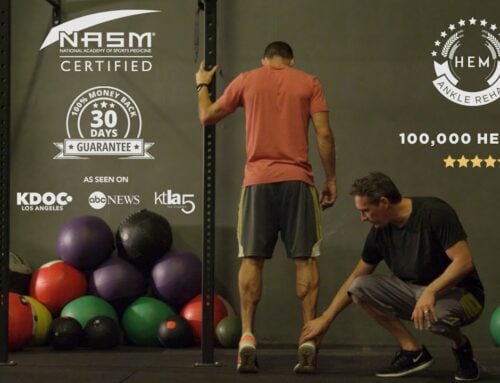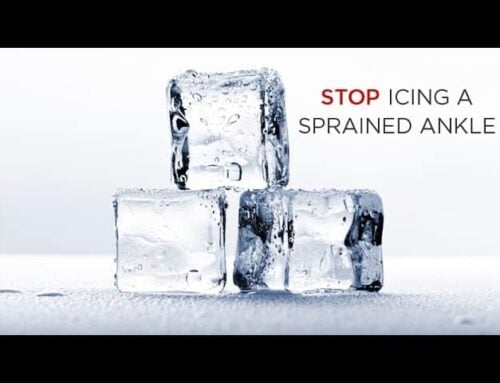
Ankle injuries are prevalent, yet distinguishing between a sprained ankle and a broken ankle can be challenging. Recognizing the symptoms and understanding the nature of each injury is crucial for ensuring proper care. This guide aims to help you tell the difference between a sprained and broken ankle, providing valuable insights into their symptoms and necessary medical interventions.
An Overview of Ankle Injuries
Ankle injuries are common occurrences that can significantly affect one’s mobility and quality of life. These injuries typically involve the ankle joint, which is composed of bones, ligaments, and tendons. A sprain occurs when ligaments around the ankle are stretched or torn, while a fracture involves a break in the bone. Accurate diagnosis is essential to determine whether the ankle is sprained or broken, as the treatment options differ significantly.
What are Ankle Sprains?
An ankle sprain happens when the ligaments that support the ankle joint are overstretched or torn, often due to a sudden twist or roll of the foot and ankle. This type of injury is characterized by pain, swelling, and sometimes bruising around the ankle. Depending on the severity, an individual may find it difficult to put weight on the injured ankle, and the range of motion may be limited.
What is a Broken Ankle?
A broken ankle, or ankle fracture, occurs when one or more of the bones in the ankle joint are broken. This type of injury can range from a small crack in the bone to a complete break. Symptoms of a fractured ankle often include intense pain, significant swelling, and an inability to put weight on the affected foot. In severe cases, the bone may be visibly out of place.
Why Is An Accurate Diagnosis Important?
Accurate diagnosis of an ankle injury is crucial because the treatment for a sprain and a fracture varies greatly. A sprain may heal with rest and rehabilitation exercises, whereas a fracture may require immobilization or even surgery. Misdiagnosing a sprained or broken ankle can lead to improper healing and long-term complications. Therefore, seeking medical attention to assess whether the ankle is sprained or broken is imperative.
Symptoms of a Sprained Ankle
What are the Common Signs of Ankle Sprains?
Common signs of a sprained ankle include pain and tenderness around the ankle joint, swelling, and bruising. The injured ankle may feel unstable, and there may be a popping sensation at the time of the injury. These symptoms can vary depending on the severity of the sprain, but typically, a sprained ankle will make it difficult to walk or bear weight on the foot.
What are the 3 Grades of Sprained Ankles?
The severity of a sprained ankle is categorized into three grades.
| Grade | Description |
|---|---|
| Grade 1 | Mild stretching of the ligaments with minor swelling and pain. |
| Grade 2 | Partial tearing of the ligament with moderate swelling, bruising, and some loss of function. |
| Grade 3 | Complete tear of the ligament, resulting in severe pain, significant swelling, and an inability to put weight on the injured ankle. |
When to Seek Medical Attention
Seeking medical attention is advisable if the ankle injury results in severe pain, significant swelling, or an inability to walk. If there is a suspicion of a fracture, such as if the bone is visibly misaligned or if the pain is extreme, it is crucial to seek prompt medical evaluation. Proper medical assessment ensures the ankle heals properly and helps prevent long-term complications.
Symptoms of a Broken Ankle
Identifying Signs of a Fractured Ankle
Identifying a fractured ankle is crucial for ensuring the right treatment. A broken ankle often presents with symptoms such as intense pain and swelling around the ankle joint. Additionally, the inability to put weight on the injured ankle is a common indicator. In more severe fractures, the bone may be visibly out of place, which can be distressing and requires immediate medical attention.
Acute Pain and Swelling in Broken Ankles
Acute pain is a hallmark symptom of a broken ankle. This pain is typically severe and can be exacerbated by movement or pressure on the foot and ankle. Swelling is another significant symptom that occurs rapidly after the injury, leading to a noticeable increase in size around the injured area. The combination of intense pain and swelling can significantly impair mobility and require immediate assessment by a healthcare professional.
Mobility and Functionality Issues
When dealing with a fractured ankle, mobility and functionality are severely compromised. The injured ankle may be unable to support any weight, making walking or standing a challenge. This lack of mobility is a key difference between a sprained ankle and a broken one. The range of motion is often restricted, and any attempt to move the foot can result in sharp pain. Seeking medical intervention is essential for proper diagnosis and healing.
How to Tell the Difference
Key Differences Between Sprained and Broken Ankles
Understanding the difference between a sprained ankle and a broken ankle is vital for appropriate care. A sprain occurs when ligaments are stretched or torn, while a fracture involves a break in the bone. While both injuries cause pain and swelling, a broken ankle often results in more severe symptoms, including the inability to bear weight and potential bone displacement. Recognizing these differences can help guide treatment options.
Diagnostic Methods for Ankle Injuries
To accurately diagnose whether the ankle is sprained or broken, diagnostic methods such as X-rays or MRIs are often employed. These imaging techniques can reveal the presence of a fracture or the extent of ligament damage. A medical professional will assess the injury to determine if a fracture may require immobilization or surgical intervention, while a sprain may be treated with rest, ice, and rehabilitation exercises.
Self-Assessment Tips for Injured Ankles
For those wondering if they’re dealing with a sprain or fracture, self-assessment can provide initial guidance. Evaluate the level of pain and swelling around the ankle. If the pain is excruciating and you are unable to put any weight on your ankle, it may indicate a fracture. However, self-assessment should not replace medical evaluation, as professional diagnosis is essential for ensuring the ankle heals properly.
Treatment Options for Ankle Injuries
Managing Sprained Ankles at Home with HEM Ankle Rehab
When dealing with a sprained ankle, the HEM Ankle Rehab method offers an effective home treatment option. This approach focuses on reducing swelling and promoting healing through exercises and movements that improve the range of motion. The HEM method emphasizes rest, ice, compression, and elevation, which are crucial to alleviate pain and swelling. This self-managed regimen can help speed up recovery and restore mobility.
Medical Treatments for Broken Ankles
If the ankle is broken, medical intervention is essential to ensure proper healing. Treatment options for a broken ankle often include immobilization with a cast or brace to support the fractured bone. In more severe cases where the bone is broken significantly or misaligned, surgery might be necessary to realign the bone and stabilize the ankle joint. Medical attention is crucial to prevent complications and ensure the ankle heals correctly.
Rehabilitation with HEM Ankle Rehab After An Ankle Injury
Rehabilitation is a vital component of recovery from both sprains and fractures. The HEM Ankle Rehab program can be adapted to aid rehabilitation after an ankle injury. This includes strengthening exercises and balance training to improve stability and prevent future injuries. Following a structured rehabilitation plan helps restore the ankle’s functionality, allowing you to put weight on the injured ankle again and regain full mobility.
Preventing Ankle Injuries
Tips to Avoid Sprains and Fractures
Preventing ankle injuries involves strategies to avoid common pitfalls that lead to sprains and fractures. Wearing supportive footwear and using ankle braces can provide stability and reduce the risk of twisting the ankle. Strengthening exercises for the foot and ankle, such as calf raises and balance drills, are also beneficial. These proactive measures can help maintain the strength of the ligaments and prevent injury.
Safe Practices in Sports and Daily Activities
Engaging in safe practices during sports and daily activities can significantly reduce the risk of ankle injuries. Warming up before physical activity prepares the ankle joint for movement, enhancing flexibility and reducing the likelihood of a sprain or fracture. Being mindful of uneven surfaces and using proper techniques during exercise can prevent the ankle from rolling or twisting, thus helping to keep your ankles healthy and strong.
Secret of the Pros
Everything You Need To Heal At Home
So, Why Rehab?
Most people think rest and ice will heal their ankle (even a severe sprain), but they end up with chronic ankle instability… 30% still have pain one year later!
And that causes all kinds of muscle imbalances in the body, which can lead more serious injuries, repeated ankle sprains and chronic ankle pain. It’s a terrible domino effect that can last for life.
That’s Where Rehab Comes In.
A great rehab program significantly improves how a sprained ankle heals. It eliminates pain fast and ensures your ankles are strong and stable with healthy range of motion, which helps prevent future sprains.
Rehab Is The Key To
Healing Ankle Injuries Fast
Recent studies have shown that rehab heals ankle ligaments safely and effectively. It’s the difference between the people that don’t heal a sprained ankle and the ones that do!
Injured Ankle
Without Rehab
Injured Ankle
With Rehab
HEM Ankle Rehab “Rehabs” Your Ankle

HEM is a complete ankle rehab and prehab program for the entire ankle, foot and calf complex. This is a very thorough program that contains so much more than anything else you can find online, but it’s still easy to do.
Scott will coach you through every step, as if you are with him, one on one. Just follow along with the videos to rebuild your ankle from the ground up.
You can expect pain free mobility and strong, stable ankles that are protected from an ankle sprain, without ankle braces!
REAL PEOPLE, REAL RESULTS
From Scott Malin, NASM-CPT, CES
Creator, HEM Ankle Rehab
October 15, 2025
Fifteen years ago, I had to give up what I love doing most… playing basketball. I sprained my ankles so many times that I could no longer play. It was devastating.
Like you, I used R.I.C.E. (rest, ice elevation, compression), but my ankles healed so slowly and badly, they eventually got so weak, I would sprain them just walking down the street!
Being a fitness trainer, the only thing I had going for me was a fascination with helping people get out of pain and strengthening their bodies.
So, I decided to research all the cutting edge techniques to heal an ankle sprain much faster and better than R.I.C.E.
After months of research, I discovered that icing an injury can have a negative affect on the body’s healing process. Studies show that ice can actually slow down healing and too much rest left the ankles weak and unstable. This was shocking, but only part of the story…
New research was suggesting a much more proactive approach to healing that involved much better rehab techniques proven to dramatically speed up the speed and quality of the healing process.
Instead of months, healing took only days. And, if you had a chronically weak ankle that was in pain, these techniques would quickly strengthen and stabilize the ankles.
I kept improving on these techniques, drawing from many different disciplines and simplified them.
Eventually, after many more months of trial and error, I created a simple at-home healing system with very reliable results.
Since I was a fitness trainer, I was able to help all my clients (celebrities and athletes) whenever they got injured. I was even on the news a few times.
The response from my clients and friends was so overwhelming that a few of them eventually convinced me to share it with everyone.
Today, I am humbled that over 100,000 people have healed fully and fast with my program.
So, if you have any kind of ankle injury (new or old), just follow along with me in the videos and I’ll show you exactly what to do until you are completely pain free.
My message is simple… you do not have to give up what you love. And you do not have to live with chronic pain from old injuries. Life is too short and there is a better way!
I truly hope you will start using my program so you can get your life back and do what you love, pain free (and yes, I still play basketball every week and LOVE it!)
Thank you!
Scott
Heal Your Ankle FAST ⇣

30 day money back guarantee
15 YEARS. 100K HEALED.

Secret of the Pros
Everything You Need To Heal At Home
REAL PEOPLE,
REAL RESULTS
So, Why Rehab?
Most people think rest and ice will heal their ankle (even a severe sprain), but they end up with chronic ankle instability… 30% still have pain one year later!
And that causes all kinds of muscle imbalances in the body, which can lead more serious injuries, repeated ankle sprains and chronic ankle pain. It’s a terrible domino effect that can last for life.
That’s Where Rehab Comes In.
A great rehab program significantly improves how a sprained ankle heals. It eliminates pain fast and ensures your ankles are strong and stable with healthy range of motion, which helps prevent future sprains.

Rehab Is The Key To
Healing Ankle Injuries Fast
Recent studies have shown that rehab heals ankle ligaments safely and effectively. It’s the difference between the people that don’t heal a sprained ankle and the ones that do!
Injured Ankle
Without Rehab
Injured Ankle
With Rehab
HEM Ankle Rehab
“Rehabs” Your Ankle

HEM is a complete ankle rehab and prehab program for the entire ankle, foot and calf complex. This is a very thorough program that contains so much more than anything else you can find online, but it’s still easy to do.
Scott will coach you through every step, as if you are with him, one on one. Just follow along with the videos to rebuild your ankle from the ground up.
You can expect pain free mobility and strong, stable ankles that are protected from an ankle sprain, without ankle braces!
100,000 PEOPLE HEALED-
-
-
-
-
-
-
-
-
-
-
-
-
-
-
-
-
-
From Scott Malin, NASM-CPT, CES
Creator, HEM Ankle Rehab
October 15, 2025
Fifteen years ago, I had to give up what I love doing most… playing basketball. I sprained my ankles so many times that I could no longer play. It was devastating.
Like you, I used R.I.C.E. (rest, ice elevation, compression), but my ankles healed so slowly and badly, they eventually got so weak, I would sprain them just walking down the street!
Being a fitness trainer, the only thing I had going for me was a fascination with helping people get out of pain and strengthening their bodies.
So, I decided to research all the cutting edge techniques to heal an ankle sprain much faster and better than R.I.C.E.
After months of research, I discovered that icing an injury can have a negative affect on the body’s healing process. Studies show that ice can actually slow down healing and too much rest left the ankles weak and unstable. This was shocking, but only part of the story…
New research was suggesting a much more proactive approach to healing that involved much better rehab techniques proven to dramatically speed up the speed and quality of the healing process.
Instead of months, healing took only days. And, if you had a chronically weak ankle that was in pain, these techniques would quickly strengthen and stabilize the ankles.
I kept improving on these techniques, drawing from many different disciplines and simplified them.
Eventually, after many more months of trial and error, I created a simple at-home healing system with very reliable results.
Since I was a fitness trainer, I was able to help all my clients (celebrities and athletes) whenever they got injured. I was even on the news a few times.
The response from my clients and friends was so overwhelming that a few of them eventually convinced me to share it with everyone.
Today, I am humbled that over 100,000 people have healed fully and fast with my program.
So, if you have any kind of ankle injury (new or old), just follow along with me in the videos and I’ll show you exactly what to do until you are completely pain free.
My message is simple… you do not have to give up what you love. And you do not have to live with chronic pain from old injuries. Life is too short and there is a better way!
I truly hope you will start using my program so you can get your life back and do what you love, pain free (and yes, I still play basketball every week and LOVE it!)
Thank you!
Scott
Hurry, sale ends soon!
30 day money back guarantee



























